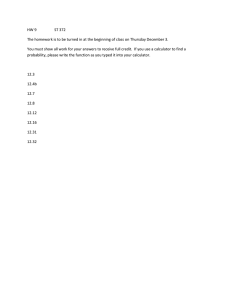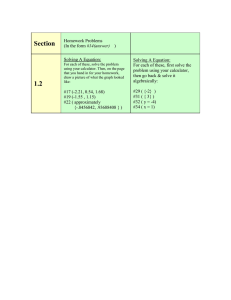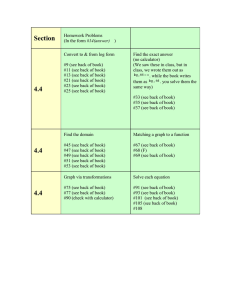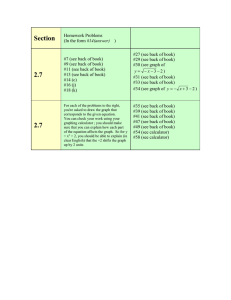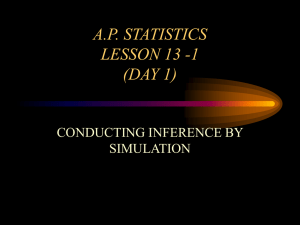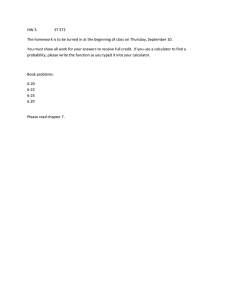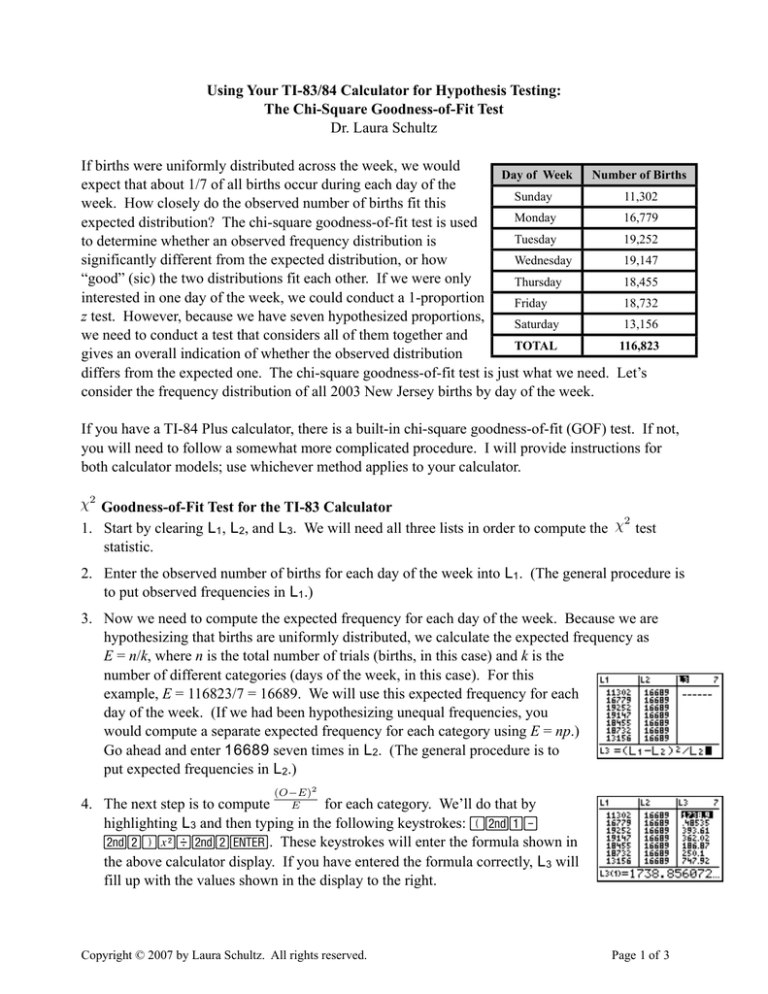
Using Your TI-83/84 Calculator for Hypothesis Testing:
The Chi-Square Goodness-of-Fit Test
Dr. Laura Schultz
If births were uniformly distributed across the week, we would
Day of Week
Number of Births
expect that about 1/7 of all births occur during each day of the
Sunday
11,302
week. How closely do the observed number of births fit this
Monday
16,779
expected distribution? The chi-square goodness-of-fit test is used
Tuesday
19,252
to determine whether an observed frequency distribution is
significantly different from the expected distribution, or how
Wednesday
19,147
“good” (sic) the two distributions fit each other. If we were only
Thursday
18,455
interested in one day of the week, we could conduct a 1-proportion
Friday
18,732
z test. However, because we have seven hypothesized proportions,
Saturday
13,156
we need to conduct a test that considers all of them together and
TOTAL
116,823
gives an overall indication of whether the observed distribution
differs from the expected one. The chi-square goodness-of-fit test is just what we need. Let’s
consider the frequency distribution of all 2003 New Jersey births by day of the week.
If you have a TI-84 Plus calculator, there is a built-in chi-square goodness-of-fit (GOF) test. If not,
you will need to follow a somewhat more complicated procedure. I will provide instructions for
both calculator models; use whichever method applies to your calculator.
χ2 Goodness-of-Fit Test for the TI-83 Calculator
2
1. Start by clearing L1, L2, and L3. We will need all three lists in order to compute the χ test
statistic.
2. Enter the observed number of births for each day of the week into L1. (The general procedure is
to put observed frequencies in L1.)
3. Now we need to compute the expected frequency for each day of the week. Because we are
hypothesizing that births are uniformly distributed, we calculate the expected frequency as
E = n/k, where n is the total number of trials (births, in this case) and k is the
number of different categories (days of the week, in this case). For this
example, E = 116823/7 = 16689. We will use this expected frequency for each
day of the week. (If we had been hypothesizing unequal frequencies, you
would compute a separate expected frequency for each category using E = np.)
Go ahead and enter 16689 seven times in L2. (The general procedure is to
put expected frequencies in L2.)
(O−E)2
E
4. The next step is to compute
for each category. We’ll do that by
highlighting L3 and then typing in the following keystrokes: (`1`2)q/`2e. These keystrokes will enter the formula shown in
the above calculator display. If you have entered the formula correctly, L3 will
fill up with the values shown in the display to the right.
Copyright © 2007 by Laura Schultz. All rights reserved.
Page 1 of 3
5. Press `M to quit the stat editor and return to the home screen. Once we add up all of the
entries in L3, we will have found the value of our chi-square test statistic:
! (O − E)2
2
χ =
E
We will use the sum function to do so. Press `S and scroll right to the
MATH menu. Then, scroll down to 5:sum( and press e. Type `3)
to indicate that you want to sum the contents of L3 and then press e.
2
6. Your calculator will now display the value of χ , which is 3679.866739 for
this example.
2
7. Next, we need to find the P-value associated with our χ test statistic. To do
2
so, press `v to get the DISTR menu. Scroll down to 8:χ cdf( and
2
press e. We want to find the probability of obtaining a χ test statistic
of 3679.866739 or higher, so type 3679.866739,1`,99,6)e to
tell your calculator to find the probability of obtaining a value between
2
3679.866739 and 1099 (an approximation for ∞) in a χ distribution with 6
degrees of freedom. (Find the number of degrees of freedom by subtracting
one from the number of categories, or k - 1. For this example, there are seven
categories and, hence, six degrees of freedom.)
2
8. We obtained a very large χ value, so you shouldn’t be surprised that there is a
very small P-value associated with it. So small, in fact, that your calculator
rounds it to 0. Don’t be alarmed when this happens; just indicate that the Pvalue is “near zero.” The P-value won’t be exactly zero, but we are unable to
2
find out just how low it is for extremely large χ values.
9. Round chi-square values to 3 decimal places and P-values to 3 significant
2
figures. You would report the results for this example as P( χ > 3679.867) ≈ 0.
10. What does this mean? If births were in fact distributed uniformly across the seven days of the
2
week, an observed χ value of 3679.867 would occur about 0% of the time. This result is
certainly unusual, so we reject H0 and conclude that the sample data are consistent with births
being non-uniformly distributed across the seven days of the week.
χ2 Goodness-of-Fit Test for the TI-84 Plus Calculator
2
1. It is relatively easier to conduct a χ goodness-of-fit test if you happen to have a TI-84 Plus
calculator. Steps 1-3 are the same as I described previously for the TI-83 calculator (except that
you only need to clear L1 and L2).
2. Once you have entered the observed frequencies in L1 and the expected
frequencies in L2, press S and scroll right to the TESTS menu. Then,
2
scroll down to D:χ GOF-Test and press e. Your calculator will
prompt you for the list with the observed frequencies (L1 for this example),
Copyright © 2007 by Laura Schultz. All rights reserved.
Page 2 of 3
the list with the expected frequencies (L2 for this example), and the number of
degrees of freedom. You can find the degrees of freedom by subtracting 1
from the number of categories (k - 1); there are 6 degrees of freedom for this
example. Next, highlight Calculate and press e.
3. Your calculator will return the output shown to the right. It gives you both the
2
value of the χ test statistic and its associated P-value. CNTRB provides a
2
list of the CoNTRiButions of each category to the overall χ value. Use >
to scroll through these numbers; note that CNTRB lists the same values that
appear in L3 when you follow the TI-83 calculator procedure above. Round
chi-square values to 3 decimal places and P-values to 3 significant figures.
2
You would report these results as P( χ > 3679.867) ≈ 0.
4. What does this mean? If births were in fact distributed uniformly across the seven days of the
2
week, an observed χ value of 3679.867 would occur about 0% of the time. This result is
certainly unusual, so we reject H0 and conclude that the sample data are consistent with births
being non-uniformly distributed across the seven days of the week.
Below I have provided the formal hypothesis test for this example. I will expect you to use this
2
same format when reporting the results of a χ goodness-of-fit test. Pay special attention to the
2
wording of the conclusion and how I report the χ value, degrees of freedom, and P-value at the
end. This was an unusual hypothesis test in that the original claim became the null hypothesis.
More typically, the original claim is tested as the alternative hypothesis.
Claim: Births are evenly distributed across the seven days of the week.
Let p1 = the proportion of births on Sunday, p2 = the proportion of births on Monday, ... ,
and p7 = the proportion of births on Saturday.
H0: p0 = p1 = p2 = p3 = p4 = p5 = p6 = p7 = 1/7 (Births are evenly distributed across the
seven days of the week.)
H1: At least one pi ≠ 1/7 (Births are not evenly distributed across the seven days of the
week.)
2
Conduct a χ goodness-of-fit test with a significance level of α = .05
Reject H0 because our P-value was near zero, and 0 < .05
Conclusion: There is sufficient evidence to warrant rejection of the claim that births are
2
evenly distributed across the seven days of the week ( χ = 3679.867, df = 6, P ≈ 0).
The M&Ms exercise that we will conduct during class tonight will provide you with an example of
how to conduct a chi-square goodness-of fit-test in situations where the expected frequencies are
not equal.
Copyright © 2007 by Laura Schultz. All rights reserved.
Page 3 of 3

